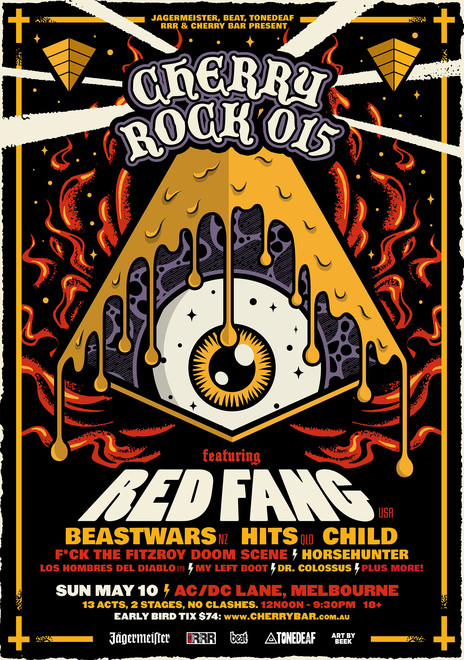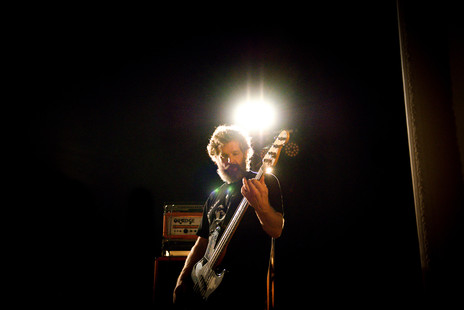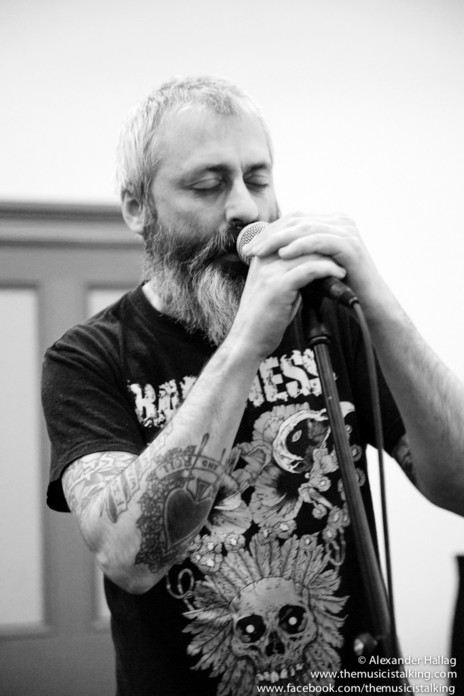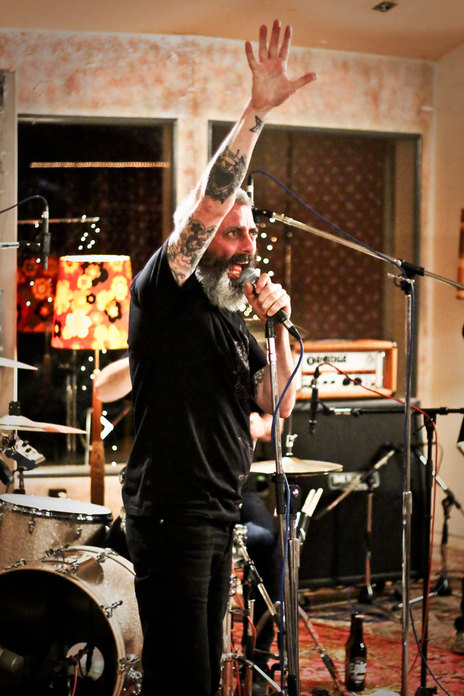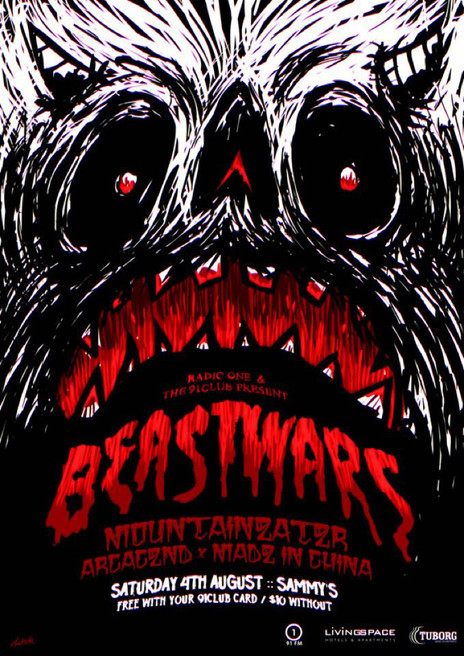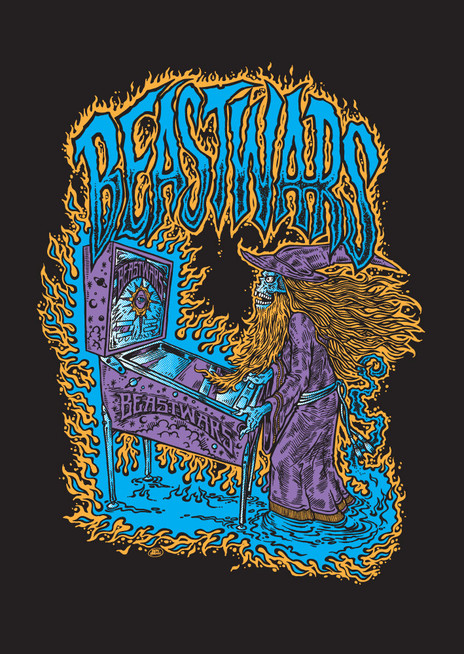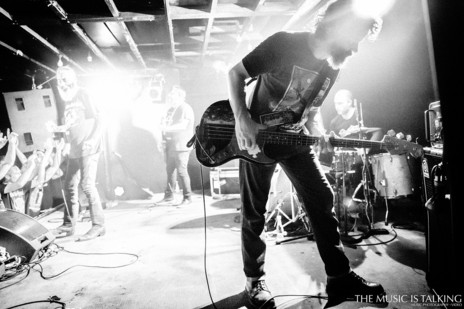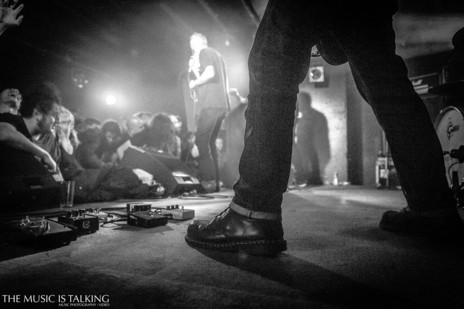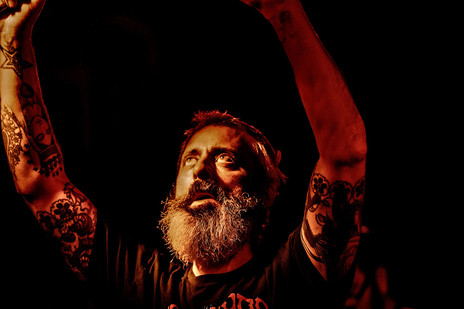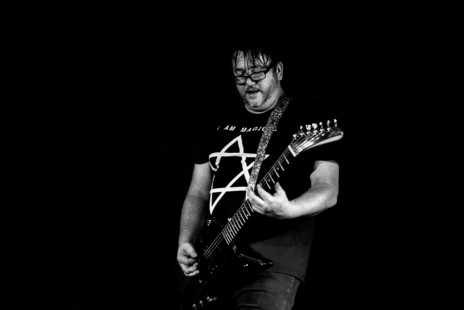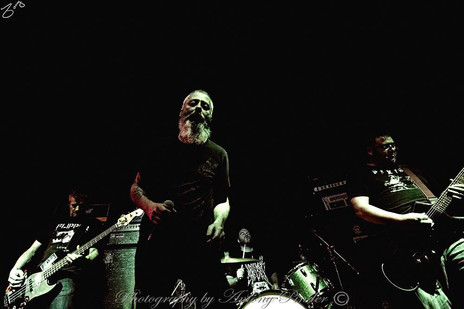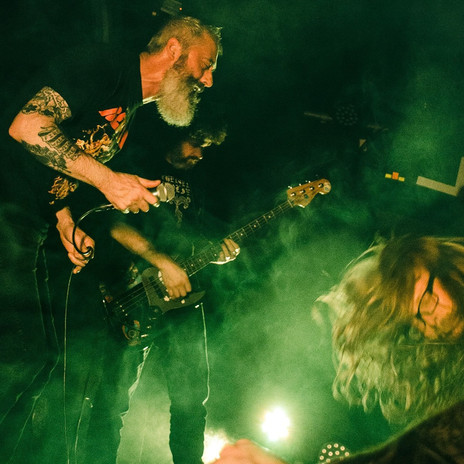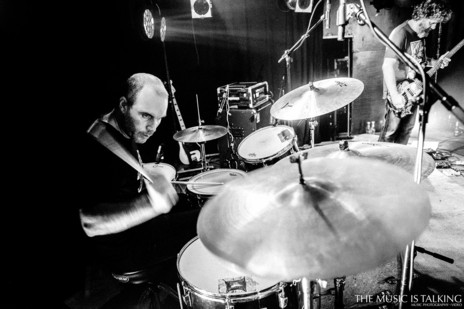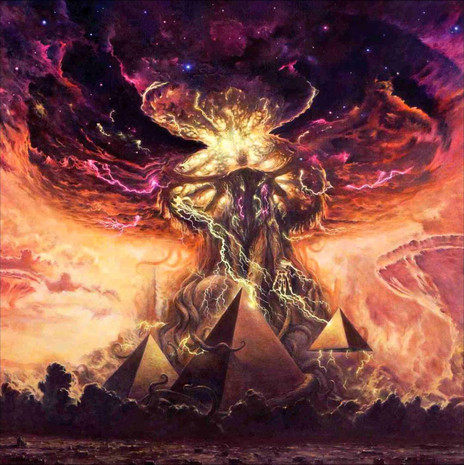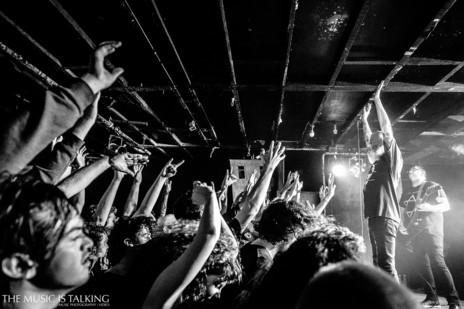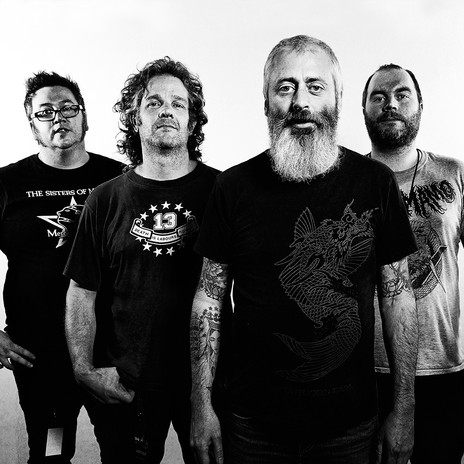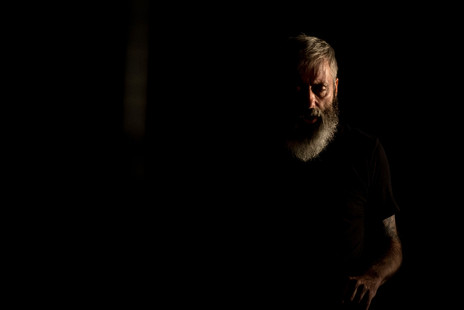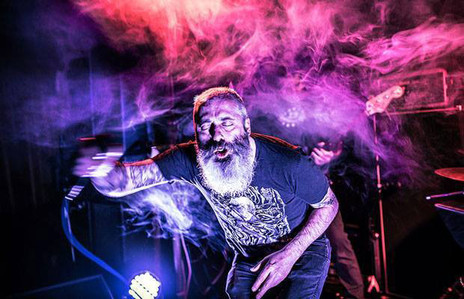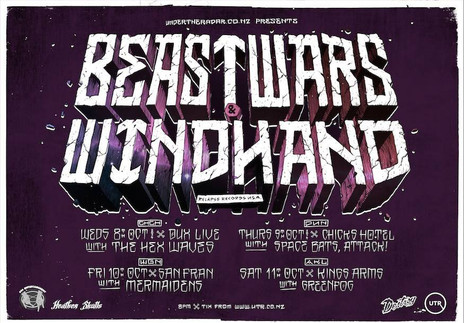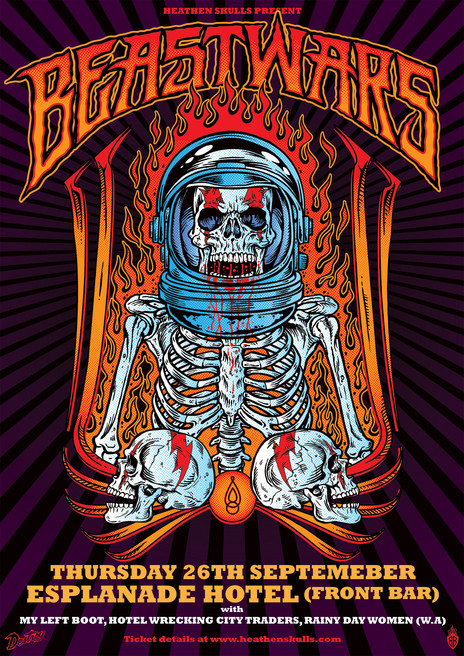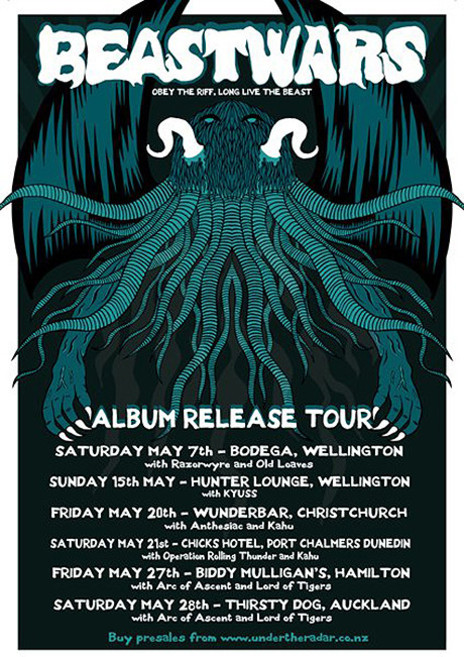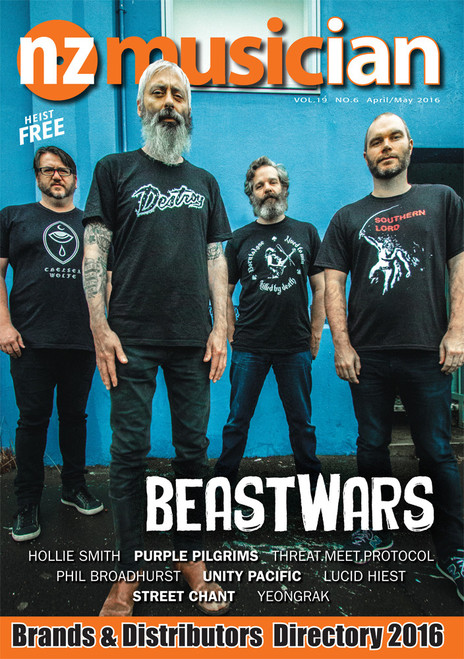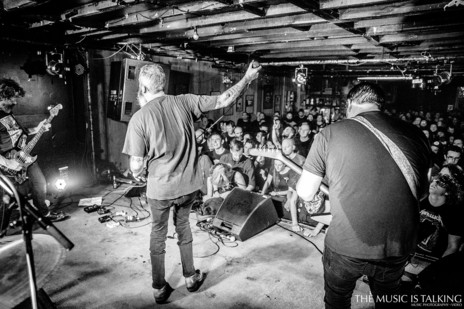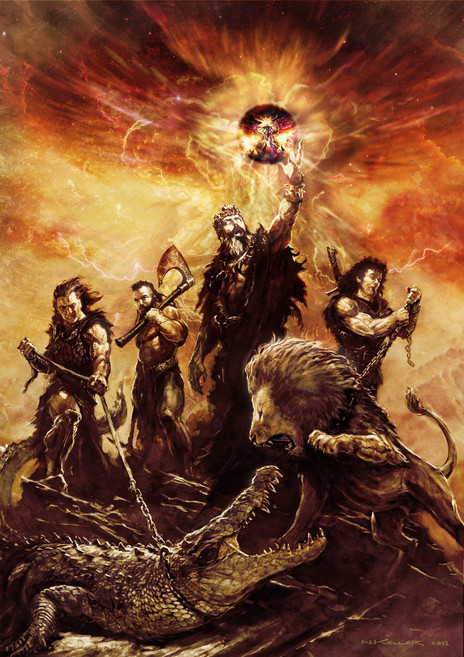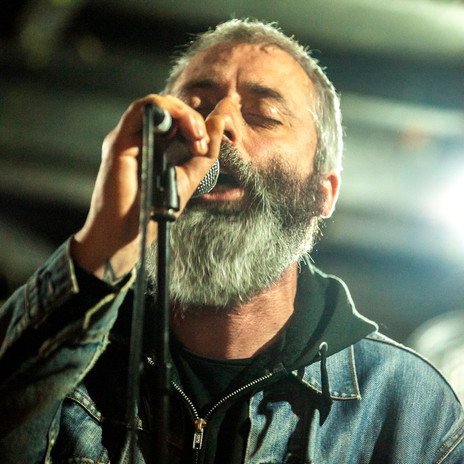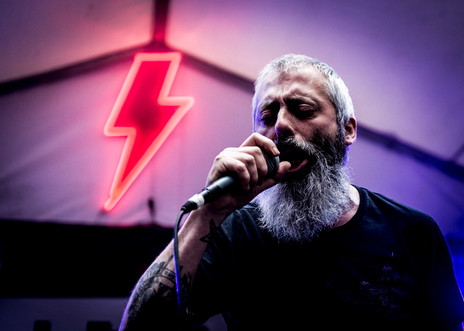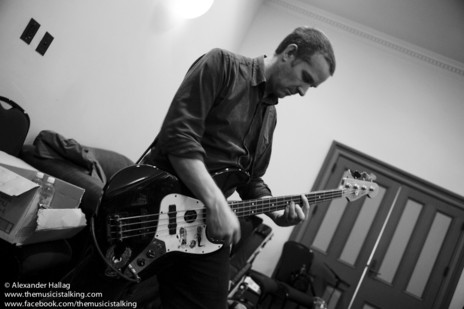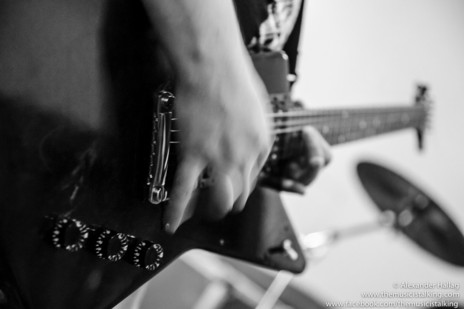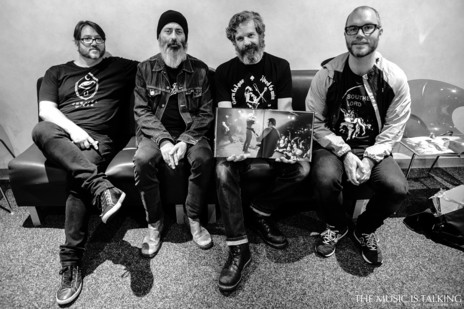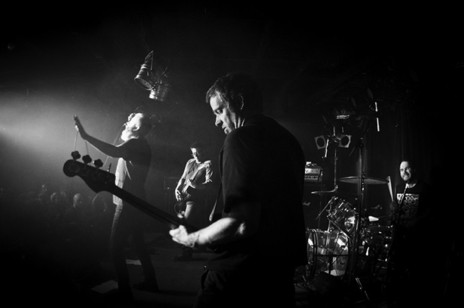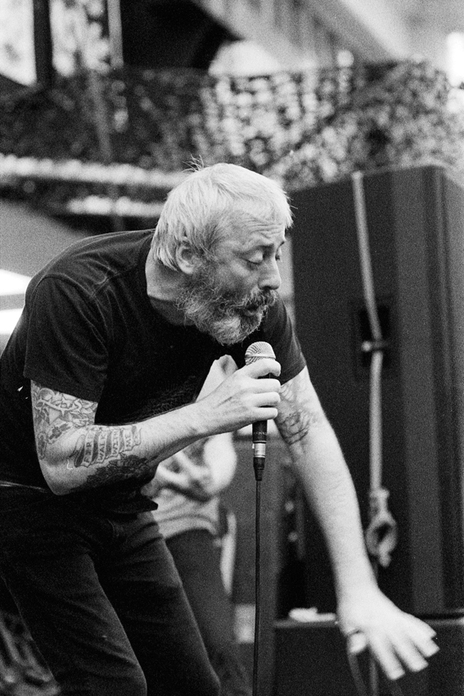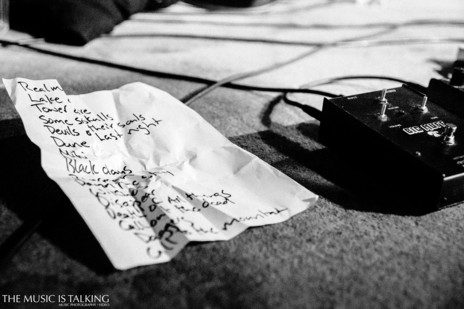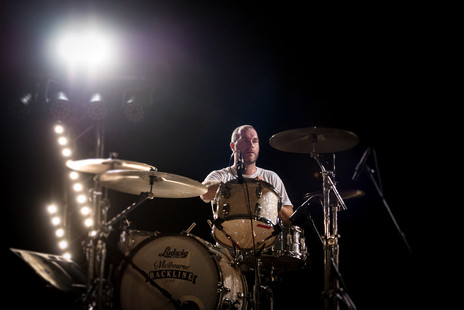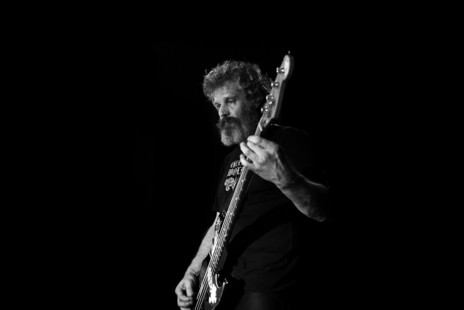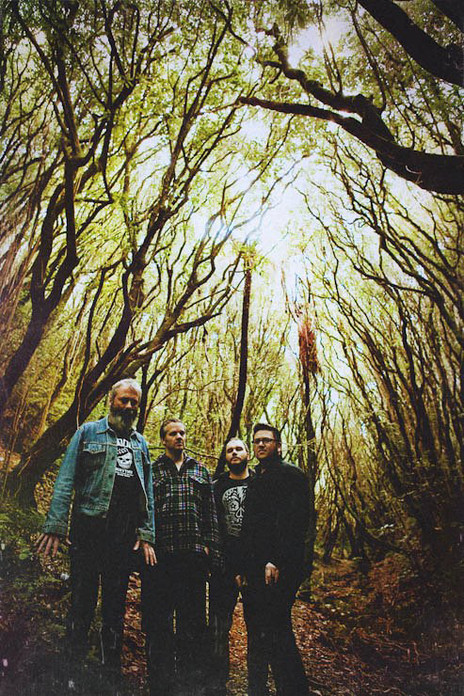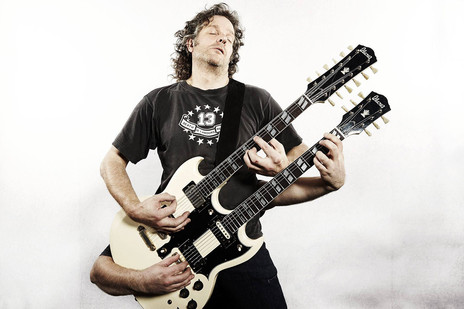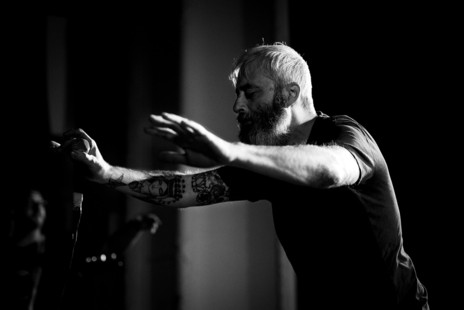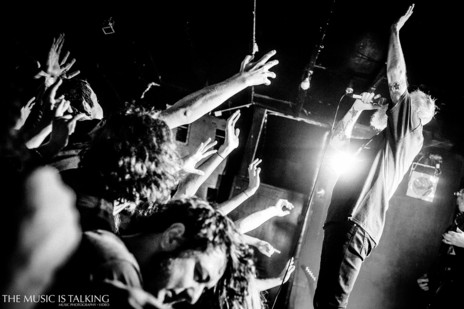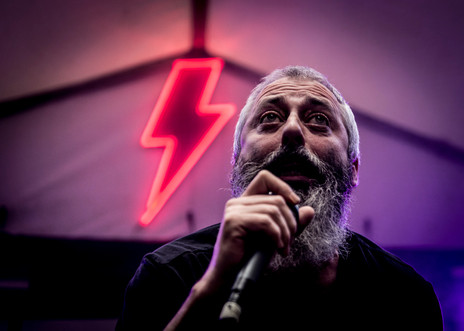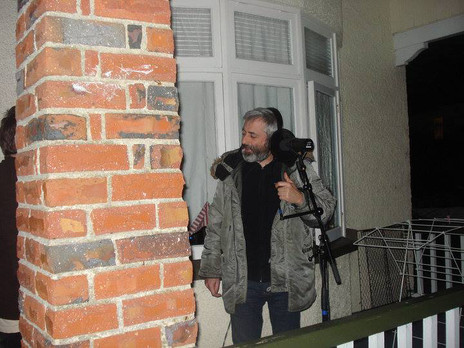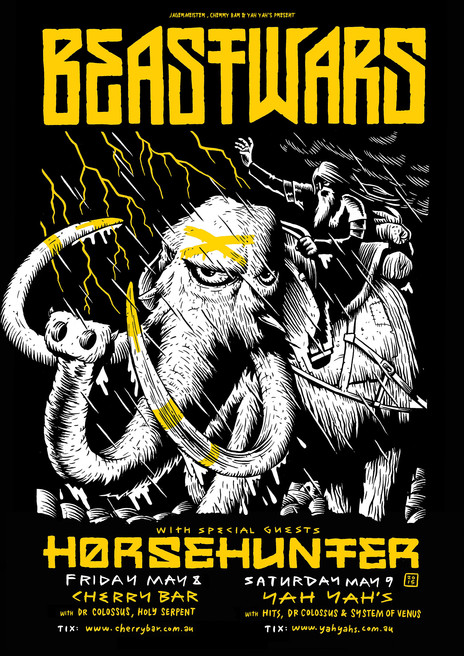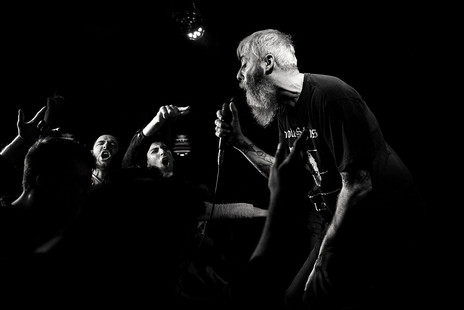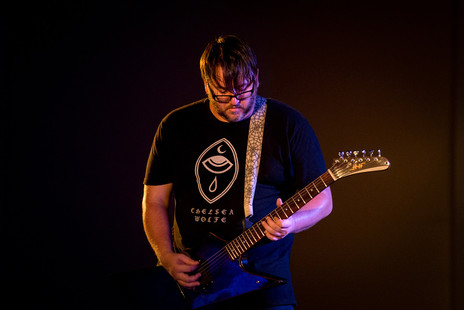Two years later, he moved on to London where he managed to see Nirvana play three times during their short lifespan. His own music career was reignited through playing with Zen Grenade – a band who signed to a Belgian label (owned by Peter Kent, Bauhaus’s old manager) and managed to get their video on MTV. They played shows throughout Europe but never got the attention they were hoping for.
For a while Hyde enjoyed living in rough London squats and pursuing his music, but by the mid-90s he found himself living in a seedy council estate and decided he’d had enough.
In Auckland, he was contacted by Aaron Carson (ex-Thorazine Shuffle and Dead Flowers) who asked him to try out for his new band, The Larry Normans (whose sound was somewhere between garage rock and Motorhead). As their bio explained: “Word around town was that Hyde had hit the wagon hard and there were concerns within the band as to whether or not he would fit in. Halfway through the intro to the first song Hyde started drinking and we knew we had our man.”
This jokingly dark story of how Hyde joined the band turned out to be prophetic. His wild antics meant the band were formidable live act and his bandmates followed suit by throwing their instruments around with abandon (and smashing a couple in the process). Unfortunately his haphazard behaviour offstage eventually led his bandmates to eject Hyde from the band in 2006 just as they were releasing their self-titled debut album.
Unknown to Hyde, the seeds of his next band were already being sown in Wellington. Nathan “Nato” Hickey was well-known on the local scene for his bass and guitar playing with bands such as retro rockers Paselode (who signed to Wildside Records), alt-country act Grand Prix (who signed to Arch Hill), and all-star group Fly My Pretties. Late one night at the Matterhorn bar, Hickey was introduced to Clayton Anderson, who had played guitar in metal bands in Blenheim and Sonic-Youth-inspired act Sifter, before becoming better known as a TV reporter on Campbell Live. The pair found they had a shared love of Kyuss so agreed to jam together (Sam Scott from The Phoenix Foundation was also at the bar and said they’d never do it, so they swore they’d go through with the plan, if only to prove him wrong!). Also Hickey had recently taken up drums so decided it was the perfect opportunity to test his ability on the new instrument.
They played an early show as an instrumental three-piece with bassist Warren Green (ex-Big Block), and Hyde happened to be in the audience. He had already met Hickey when Larry Normans supported Paselode at The Kings Arms (around 2004) so arranged to come to a band practice at some point. However, the band faltered when Green announced he was moving to Auckland. Fortunately, Hickey had also talked with soundman James Woods about forming a band and so brought him onboard: “I had seen James play a couple of shows with his noise rock band Beretta and loved his monstrous bass sound.”
When Hyde joined them, he pushed his vocals even further towards a rasping growl.
The core of the Beastwars sound came together quickly: Hickey laying down heavy, rudimentary beats which Anderson riffed over, while Woods provided grinding, distorted bass lines, often filling out their sound by playing full chords. When Hyde joined them, he pushed his vocals even further towards a rasping growl. In other words, he sounded like what he was: a heavy rock singer who had spent 15 years yelling like Lemmy and with the same dark outlook on life as Nick Cave.
Instantly, the others knew their band had found what they didn’t know they were missing. Hickey recalls: “Before Matt joined our music was probably more in a Queens Of The Stone Age vibe. Once he joined the music we wrote and how we played it got much heavier due to the power of his voice … We formed in 2006 and didn't play our first show as a four piece until 2009. I think we hadn't wanted to jump straight into playing shows because we wanted to be good as soon as we hit the stage. I hadn't played drums before starting Beastwars so I had to learn how to play ...”
Beastwars
Beastwars steadily grew an audience through regular shows at Mighty Mighty on Cuba St and a support slot with The Melvins and High On Fire. Their music somehow managed to reach both fans of dark indie rock and pure-hearted metallers. Yet, it took a couple of years before they considered recording an album. Both Hyde and Woods were in their 40s and had kids, so their aspirations for the band were initially just for a fun side project rather than a serious endeavour.
Fortunately, Woods was close friends with sound engineer Dale Cotton. In the early 90s, Woods was living in Dunedin and wanted to record local bands so started Broken Ear Studio on Carroll St. However, he had hardly any equipment so Cotton brought some of his own gear and other equipment borrowed off local friends so the studio could get underway (Woods went on to record acts including Alastair Galbraith and Polyp). During the intervening years, Cotton became a well-respected sound engineer and had worked with bands like HDU, Dimmer, and The Subliminals.
Beastwars arranged to fly down for five days to record an album with Cotton, figuring that if they didn’t have the distractions of their home city, they could focus purely on their work. The time pressures often meant working until 3am and then starting at 9am again the next morning, but the band relished the challenge – and the one bonus of having day-jobs was that they knew how to work to a deadline. They slept nights at the studio and had dinners with Cotton’s family, while spending the rest of their time recording.
Cotton continually pushed them to try new approaches – as when he set up Hyde on the street outside the studio at 1am to record the vocals for ‘Call Out The Dead’. From the start, Hyde had written his lyrics from ad-libbing along with the music his compatriots had come up with, and then he would follow the best lines towards a subject for each song. Invariably, the themes turned towards the big concepts: life and death. One song, ‘Cthulhu’, describes a ship going down and its crew drowning – one morning, the band was watching the news and discovered that a Korean fishing vessel had sunk off the coast of Port Chalmers around the same time that they had been working on the song in the studio ...
Despite the timeframe, the band had their album in the bag and released it on vinyl with a gob-smacking cover painted by Nik Keller, who worked at Weta Digital as his day job (it went on to win best cover at the NZ Music Awards). The NZ Herald gave the album five stars and described it as “a mongrel mix of Kyuss, Neurosis, and the mighty Godflesh, Beastwars bring together pummelling intensity, beautiful brutality, and sonic paranoia to create a sound all of their own.” The band’s hard work on the live scene over the past five years paid off when their self-titled debut (2011) leapt into the New Zealand album charts at No.15.
Blood Becomes Fire
The success of Beastwars’ first album was matched by another milestone the following year when their album release tour included a show with Kyuss: the band that had inspired them to start playing music together in the first place. In 2012, they also played at the Big Day Out and Camp A Low Hum.
The band took a similar approach to the recording of their second album, though this time giving themselves the relative luxury of 10 days at Dale Cotton’s studio rather than just five. Nonetheless, Cotton pushed the band hard, and by day four they’d adopted rules to keep them focused: no drinking before 5pm and no cell phones in the studio.
The resulting album, Blood Becomes Fire (2013), was hewn from the same cloth as their debut (throat-tearing vocals, sludgy bass, grinding guitar riffs, and slow pounding drums), but the intensity had been dialled up a notch, especially when it came to the lyrical outlook. Hyde had been raised a Catholic, but had been musing on the ways in which people worshipped before the birth of modern religions. Hence his lyrics were rife with talk of blood and earth and fire, as well as predictions for a coming apocalypse (as much taken from history as from contemporary wars and the environmental devastation of our planet).
Hickey was especially taken by the support they received from their record label for the release: “Universal New Zealand were excellent to deal with and came up with the ‘don't let your mum decide number 1’ idea that pitched us against Michael Bublé!”
Bublé was too strong, but Beastwars came as close as possible – entering the charts just behind him at No.2 and thereby cementing their place as New Zealand’s most popular heavy band. Their growing notoriety saw them open for Mastodon and play two Australian festivals – Cherry Rock in Melbourne and Doomsday Festival in Sydney, where they found an eager audience for their music (leading to more Australian tours in subsequent years).
Death Of All Things
The songwriting for Beastwars’ first two albums mainly started out with Hickey, Anderson, and Woods creating basic song structures which then Hyde would write to and then adjustments would be made along the way until the song was completed. Yet, the band gradually found other ways to work together. Another change was recording with Wellington engineer, James Goldsmith, at his Blue Barn studio: a large room that ensured a huge sound for Hickey’s drums.
Initially they discussed the idea of writing short guitar pieces to join the songs on their next album, but eventually decided this would use up too much of the run time. One of these fragments was a riff written by Hickey, but which Hyde turned into the track ‘The Devil Took Her’ and saw them exploring new sonic options with backing music primarily played on acoustic guitar, cello, and flute. The lyrics reflect on an evening out drinking that ended badly and caused a rupture in Hyde’s relationship. Ironically this song came at a time when Hyde was actually reducing the amount he drank while writing and performing music, as he explained on The Void interview show:
“My main skill used to be getting drunk and falling off stage.” – Matthew Hyde
“When we were recording it, I was drinking and I fell down the stairs. I thought, fuck this, I’m not going to drink any more. Then I went back and did the whole album – my vocal stuff – sober and I think I got an amazing result out of it … When I was young, I loved alcohol, it was awesome … But I was like – I’m sick of this … I’ve been in so many bands in England and New Zealand. My main skill used to be getting drunk and falling off stage. I thought that was my job, but in reality it was not. You have to be able to sing the songs, do the shows, and write some songs.”
During the time when they were writing songs for the album, Hyde was flatting with Anderson and was woken one morning by the guitarist prodding him in the ribs, keen to share a new riff he had come up with. An image immediately came into Hyde’s mind of a set of girls who’d been at a party the night before – the late hour had played tricks on him and in his mind’s eye he saw them doing incantations and evoking dark magic.
When it came time to make a video for the song, the band was inspired by the dismissive comment of a record label exec who had responded to a video of the group by gasping in shock: “They’re so old!” As a playful response, they created an otherworldly band of youthful female musicians to take their place in the ‘Witches’ video, including Geneva Alexander-Marsters from Soccerpractise on bass and Rachael Elf from Green Fog on drums (she also joined them onstage to play the song at their album release show).
The band’s sardonic humour was also at play in the video for ‘Some Sell Their Souls’. They had recently done a live video for the Sundae Sessions and many of the comments had mocked the sedate audience shown watching them. In the subsequent music video, the lyrics are mouthed by members of a support group in a quiet community hall – at least until the band appear and things take a supernatural turn.
Yet again their work was rewarded with a high chart placing – Death Of All Things (2016) debuted at No.5 on the album charts. It would have done even better if it wasn’t for the death of Prince (two compilations of his work were in the top five) and the surprise release of a new Beyoncé album. More’s the pity, since having Anika Moa’s Songs For Bubbas 2 at No.1 followed by Death Of All Things would’ve made for an entertaining juxtaposition!
The group had achieved exactly what they had set out to do by releasing a trio of highly original and massively popular albums, which Hickey sees as a testament to their approach:
“I am really proud of what Beastwars achieved especially as we did it on our own terms and our own way. We did have help from NZ On Air who were a great help and luckily just as we were releasing music the criteria for funding changed which meant we could make videos we wanted and spend more time recording.”
What’s more, the band had more reach overseas than Hickey could’ve ever expected.
“Finding a worldwide audience – as niche as it was – was a big surprise. We just put the first album out on Bandcamp and didn’t send copies of the album to any overseas blogs or other press and it was just organically picked up. New Zealand writer Craig Hayes of Six Noises championed us and was writing for Popmatters at the time and had a good network of writing buddies who I think picked up on us through him. Especially in Australia – Melbourne was magical. We played that city more times than we played Auckland and had a great fan base there. James Young, the owner of Cherry Bar, took a shine to us so would regularly fly us over and we played Cherry Rock in AC/DC Lane two years in a row. Our final headline show was sold out at Ding Dong Lounge with about 400 people. It was a great night.”
In late 2017 it was announced that Hyde had been diagnosed with cancer.
All possibility of a fourth album was pushed aside when Hickey announced that he was moving to the UK, leaving the band on an indefinite hiatus. Fans of the group received far worse news the following year, when it was announced in October 2017 that Hyde had been diagnosed with a cancer called Non-Hodgkin lymphoma. His lengthy run of chemotherapy meant he was unable to work so the band put up for sale rare pressings of all three of their albums on vinyl, as well as a special run of T-shirts. The response from fans was immediate – the albums sold out, along with most of the T-shirts. A fundraiser was also held at Whammy Bar in Auckland raising around $2500, and Hyde requested half of the money be donated to Leukaemia New Zealand.
The great success of the fundraising campaign sparked the idea in Hyde to reunite the band for a new album. With a gruelling chemotherapy journey ahead of him, it was something to look forward to – as well as a much needed creative release. During his treatment, Hyde lived in a secluded flat in Wellington’s Wilton Bush. “It was very, very silent,” he told AudioCulture in 2020. “I felt like I was adrift, waiting for life to begin.” During this strange and lonely time, Hyde wrote diary entries that would later become his lyrical inspiration for album number four – he also drew material from much older entries from the Beastwars’ most dysfunctional moments as a band.
Hyde completed his last chemotherapy treatment on 5 January 2018, and by the end of the same month Beastwars was in the studio recording. As he told AudioCulture, “It was almost like a kick start back into life again”. Drummer Hickey, who also produced the album, flew over from the UK and lived with Hyde and his daughter Nina for the duration of the recording. They enjoyed having Hickey as a flatmate. Hyde would record in the morning then return home to sleep (it was just weeks since his last treatment), whild Hickey would stay at the studio all day then work on riffs at night back at the house. Hyde said of Hickey: “His work ethic was fucking intense. He just didn’t stop.”
Hyde’s treatment was successful – or, as the band’s Facebook page charmingly puts it – he “slayed the cancer dragon”. The band embarked on gigs in New Zealand and Australia, before joining Shihad on a national tour in the winter of 2018.
In June 2019, their new album IV debuted at No.1 on the New Zealand Album Charts – a monumental first for the band. That night, they played to a packed out audience at Christchurch’s Bluesmoke – a night they’ll never forget.
Hyde attributes the Shihad tour as allowing them reach a different crowd, one that helped propelled them to their first number one spot: “Shihad opened us up to a new audience, maybe a more mainstream audience that we hadn’t played to, which I believe affected it. I believe it was the final push needed for us to get to number one. Obtaining new fans to push us over the line. We’d been close in the past, but not close enough!”.
They toured the new material in Australia and New Zealand, enjoying their largest ever crowd, over 750, at Obey the Riff festival in Upper Hutt, alongside international acts such as Uncle Acid and the Deadbeats, Witchskull and Potion. IV also earnt critical success with two nominations at the New Zealand Music Awards – for best rock album and best group – as well as their third nomination for the Taite Music Prize.
Beastwars were set to embark on their first European tour in June 2020, kicking off at Germany’s Freak Festival. Due to COVID-19, the tour has been re-scheduled for 2021 – which is actually quite fitting, considering the overwhelming theme of IV is isolation. The irony of the situation is not lost on Hyde, but he’s feeling positive about the future of Beastwars. As he told AudioCulture, “It’s just continues, the band continues, every time you think it’s ending, there’s a new start.”
He describes the band as a family, “warts and all”. “Maybe we’ve learnt to give each other more space. Appreciate each other and respect each other … Everyone is on own their own journey, that’s the great thing because it’s the same individuals still here, who have confronted obstacles and worked their way around it, and we continue to make art.”
--
Updated by Rosie Howells
